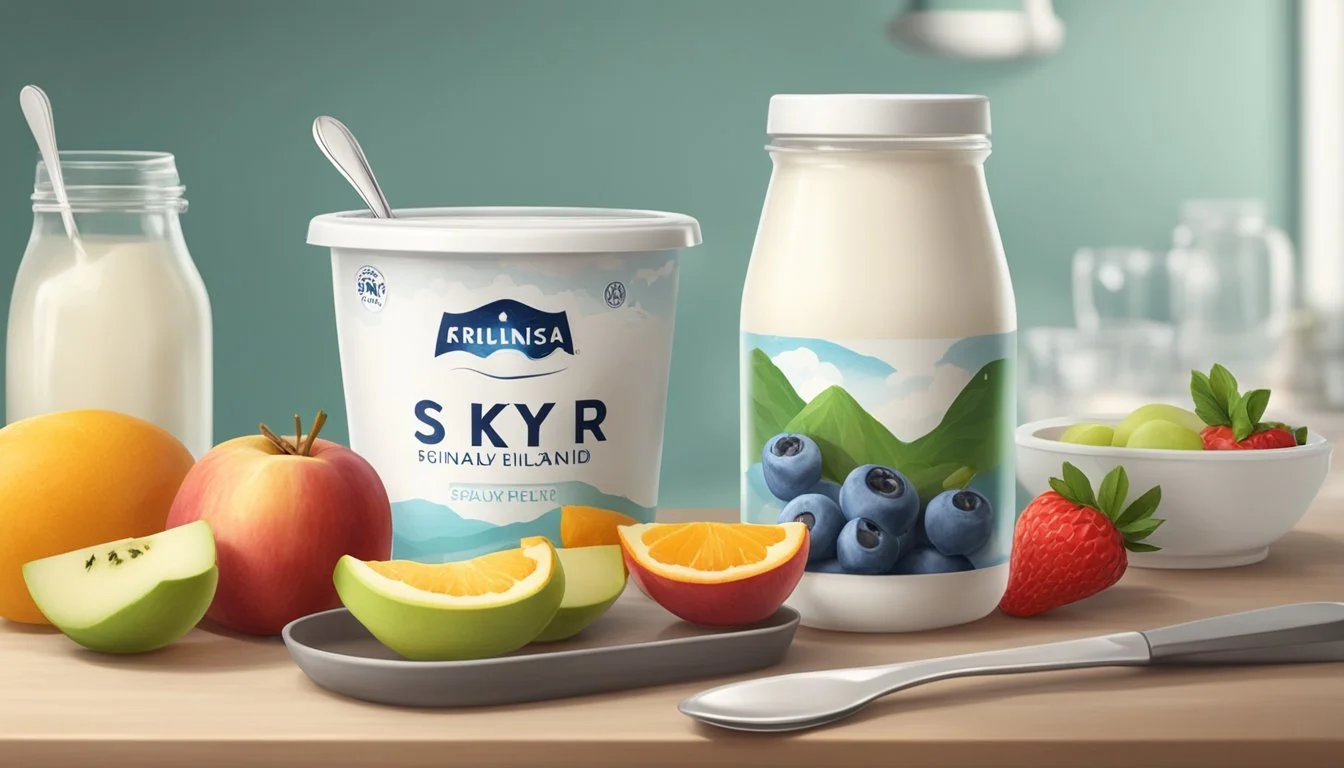How Long Does Icelandic Skyr Last?
Shelf Life and Storage Tips
Icelandic skyr, a staple in the Icelandic diet, has been cherished for centuries, not the least for its long shelf life. Rooted in Viking traditions, skyr is a cultured dairy product similar to yogurt, but with distinct processes that contribute to its longevity. While modern refrigeration has changed food storage, skyr's historical ability to last through harsh winters still benefits consumers today.
When properly stored in the refrigerator, skyr can remain fresh for several weeks. Its extended shelf life compared to regular yogurt is largely thanks to the specific strains of bacteria used in its fermentation process, along with its higher protein content and lower sugar levels. These factors make skyr not only a nutritious option but also a practical choice for those seeking a dairy product that maintains its quality over time.
Skyr's durability is also enhanced by the traditional method of preparation, which involves skimming the cream from milk, pasteurizing it, and then inoculating with live active cultures. The result is a thick, creamy product that is rich in protein and calcium while being low in fat. The production techniques, combined with its nutritional profile, ensure that skyr can stay fresh longer than many other dairy products when kept at appropriate temperatures.
Origins of Icelandic Skyr
Icelandic Skyr is a cultured dairy product with deep historical roots, tracing back to the era of the Vikings. Its cultural importance in Iceland is evident through its continued presence in the Icelandic diet and its burgeoning popularity abroad.
Viking Heritage and Sagas
Skyr's origin dates back over a thousand years when Norse settlers first brought the tradition of skyr-making to Iceland. The methods used were detailed in ancient Icelandic texts known as sagas. These sagas convey not just tales of heroism but also the dietary practices of the Vikings, attesting to skyr's role in their sustenance.
Cultural Significance in Iceland
In Iceland, skyr holds a place of cultural significance, being an integral part of the Icelandic diet for centuries. Produced originally from sheep's milk and now predominantly from cow's milk, it is enjoyed for its creamy texture and nutritional benefits. Organisations like MS Iceland Dairies, a cooperative made up of over 700 family-run dairy farms, ensure the tradition of skyr-making continues to support the local culture and economy.
Adaptation and Spread to Other Countries
Skyr's popularity has transcended Icelandic borders, adapting to global tastes and spreading to other countries. While traditionally consumed with cream and sugar in Iceland, the versatility of skyr allows for a variety of culinary applications. Its thick texture and high protein content have contributed to its rise in popularity as a healthier alternative to other dairy products in various markets around the world.
Icelandic Skyr Production
The production of Icelandic skyr begins with high-quality milk and incorporates traditional methods that date back to the Viking Age, as well as modern advancements that meet today's demand.
Traditional Making of Skyr
Traditionally, skyr was made by separating the whey from milk, originally from sheep, but now primarily from cows. This soured milk was then heated with skyr cultures, which include beneficial bacteria such as Lactobacillus bulgaricus and Streptococcus thermophilus. The addition of rennet helped in coagulating the milk to produce the uniquely dense and creamy texture of skyr.
Modern Industrial Processes
Today, industrial processes have streamlined skyr production while still adhering to its authentic methods. Large-scale dairies, such as MS Iceland Dairies, handle pasturized milk from over 700 family farms. Technologically advanced equipment ensures the consistent quality of the product, which involves heating the milk, adding skyr cultures, and meticulous temperature control to allow for proper fermentation.
Key Ingredients and Skyr Cultures
The cornerstone of skyr production is undoubtedly the selection of key ingredients:
Ingredients Role in Production Milk Base for skyr, providing proteins and fats Skyr Cultures Introduce fermentation and develop flavor Rennet Aids in coagulation to thicken the skyr
These elements work in unison, with the skyr cultures being particularly crucial for flavor and texture. As the cultures ferment the milk sugars, they transform the liquid milk into a thick, protein-rich skyr.
Nutritional Profile of Skyr
Skyr, an Icelandic dairy product, is applauded for its rich nutrient profile, which primarily includes high protein content and a modest calorie count.
Macronutrients and Calories
Skyr is a nutrient-dense food, relatively low in calories but abundant in protein. A typical serving size of Skyr contains:
Calories: 110
Protein: 17g
Fat: 2g
Carbohydrates: 6g
Fiber: 0g
Sugars (naturally occurring from milk): 6g
Vitamins and Minerals Content
In addition to its macronutrient content, Skyr offers essential vitamins and minerals. Notable among them are calcium, important for bone health, and a spectrum of vitamins vital for overall well-being. It's worth noting that due to the fermentation process, Skyr can be easier to digest for those with lactose intolerance.
Comparison to Other Dairy Products
When considering the shelf life of Icelandic skyr in comparison with other dairy products, key factors include protein content, fat percentage, and the type of milk used in its production.
Skyr vs. Greek Yogurt
Icelandic skyr and Greek yogurt are similar in that they both have a high protein content and a thick texture which may influence their lasting power. Skyr typically has even higher protein levels than Greek yogurt, with approximately 20 grams of protein per serving. Greek yogurt is made using full-fat sheep's milk traditionally, but cow's milk can also be used, which alters its fat content and could affect its longevity when stored.
Skyr vs. Conventional Yogurt
Conventional yogurt often has a lower protein content and higher sugar levels than skyr. The protein-packed nature of skyr, alongside its reduced sugar content, might contribute to a potentially longer shelf life when compared to conventional yogurt. Most conventional yogurts use a variety of milk from full-fat to skimmed milk, which can impact their preservation timeline.
The Role of Fat Content
Lower fat content in dairy products often means a longer expiration date. Icelandic skyr is generally made from skimmed milk, which not only contributes to its reduced fat but may also extend its shelf life as compared to dairy products with a higher fat content, like some cheeses or full-fat yogurts. The fat percentage is integral in determining the longevity of dairy products in the refrigerator.
Consumption Patterns
Incorporating skyr into daily meals reflects its versatility within the Icelandic diet, both as a key player in nutrition and as a culinary staple enjoyed in various forms, from a quick breakfast to a delightful dessert.
Skyr in the Icelandic Diet
Skyr has been an integral part of the Icelandic diet for over a thousand years. It is high in protein and calcium with a rich texture and serves as a nutritious ingredient throughout the day. One could find it served during breakfast, often accompanied by oats or fruit, making for a fulfilling start to the day.
Skyr as a Meal and Dessert
While skyr can serve as a standalone meal, especially for those seeking a protein-packed option, it is also celebrated as a traditional dessert. An Icelander might top their skyr with cream, a sprinkle of sugar, and berries when in season to create a simple yet satisfying dessert.
Pairing with Other Foods
Skyr complements the flavors of various Icelandic dishes. It can be used as a condiment or side with fish, lamb, and other seafood staples, enriching the meals with its creamy texture. For a complete experience, one might encounter skyr on a breakfast buffet alongside local dishes, showcasing its role as a food pairing in Iceland’s diverse palette.
Health Benefits of Skyr
Skyr, the Icelandic yogurt-like dairy product, offers a robust profile of nutrients that contribute to several health benefits. It is particularly known for its high protein content, which supports weight management, live cultures that aid digestive health, and significant calcium levels to enhance bone strength and density.
Weight Management
Skyr is high in protein, which can be beneficial for those looking to manage their weight. The protein content in skyr helps promote satiety, reducing the total caloric intake by helping individuals feel full for longer periods. This can assist in weight loss or maintenance as part of a balanced diet.
Digestive Health
The live cultures found in skyr are probiotics that contribute to the maintenance of a healthy gut flora. Regular consumption of these live cultures can aid in digestion and help keep the digestive system running smoothly. Probiotics are known to support immune function as well.
Bone Strength and Density
Skyr is an excellent source of calcium, a mineral essential for bone strength and density. Adequate calcium intake is vital for maintaining bone mass and preventing osteoporosis. The dairy product also often contains vitamin D, depending on the milk source, further supporting calcium absorption and bone health.
Recipes and Usage Ideas
Icelandic Skyr stands out not just for its thick texture and rich taste, but also for its versatility in a variety of recipes. Whether one is looking to explore traditional Icelandic dishes, experiment with new culinary creations, or accommodate specific dietary needs, Skyr can be a staple ingredient.
Traditional Icelandic Recipes
In Iceland, Skyr is traditionally enjoyed with a sprinkle of sugar and a side of cream or milk. More commonly, it is served with berries or a spoonful of jam for a touch of sweetness. Here's a classic approach:
Skyr with Blueberries:
Serve a bowl of Skyr topped with fresh, organic blueberries.
Optionally, drizzle with honey if a sweeter taste is desired.
Innovative Skyr Recipes
Skyr takes a modern twist in numerous recipes, merging classic taste with creative culinary methods. One could fold Skyr into their breakfast routine or utilize it as a healthier baking substitute:
Skyr Banana Bread:
Incorporate Skyr and protein powder into traditional banana bread recipes for a protein-rich treat.
Skyr Toast Toppings:
Spread it on toast and top with pickled herring, onions, radishes, chives, and cucumber for a savory Icelandic twist.
Skyr for Special Diets
Skyr is naturally vegetarian-friendly and can be adapted into recipes for various diets, including vegan and low-carb options. Vegans can find plant-based versions, and those on a low-carb diet can enjoy Skyr as a high-protein, fat-free food source:
Vegan Skyr Alternative:
Non-dairy milk alternatives can be used to make a vegan version of Skyr.
Top with a vegan variety of jam for flavor enhancement.
Skyr in Paleo Diet:
Skyr fits well within a paleo diet, serving as a substantial source of calcium and protein.
It pairs excellently with fruits or nuts for a nutrient-rich meal or snack.
Skyr in the Market
Skyr, a traditional Icelandic dairy product, has evolved from a regional staple to a globally recognized item. This protein-rich food is now readily available in various markets, thanks to widely recognized commercial brands and growing consumer interest in healthier food options.
Commercial Brands
Several brands have emerged as major players in the skyr market. Icelandic Provisions is the only producer in the US using traditional Icelandic skyr cultures and an original Icelandic recipe. Arla and Siggi’s Skyr are two other notable brands that not only honor the Icelandic heritage but also cater to the consumer base interested in the authentic taste and health benefits of skyr.
Global Accessibility
Skyr has significantly transcended Icelandic borders, finding a place in America and beyond. Exports of skyr have grown, and it is now a common item in American grocery stores, indicating the U.S. market's embrace of this dairy product. Consumers can find it at a variety of retail locations, from specialty health food stores to major supermarket chains.
Consumer Trends
Demand for skyr is influenced by its rich protein content and reduced sugar levels compared to standard yogurts. These trends reflect a shift towards more nutritious and wholesome diets. Consumers are increasingly gravitating towards food products that support a healthy lifestyle, and skyr's rise in the market reflects this preference.
Storage and Shelf Life
The longevity of Icelandic Skyr is closely tied to its storage conditions. For optimal freshness and to preserve its texture, Skyr should be stored in the refrigerator at or below 40°F (4°C). Under these conditions, unopened Skyr usually maintains its quality for 2 to 3 weeks past the sell-by date.
Once opened, Skyr should be consumed within a week, with the container sealed tightly when not in use. Factors that may affect Skyr’s shelf life include exposure to higher temperatures and the introduction of contaminants from utensils or handling, which can encourage bacterial growth.
Key Points:
Temperature: Maintain constant refrigeration to extend the product's life.
Sealed Packaging: Keep the Skyr in its original packaging until the initial use.
Covered: After opening, ensure the Skyr is tightly sealed before storing it again.
For those looking to enhance the flavor profile of Skyr, it is often paired with cream. However, adding cream or other ingredients does not change the storage requirements but might slightly alter the shelf life once mixed.
In terms of nutritional benefits, Icelandic Skyr is a protein product, containing significantly more protein and less sugar compared to regular yogurt. The preservation of these benefits is best maintained by adhering to recommended storage guidelines.
Factor Recommendation Temperature Store at or below 40°F (4°C) Consumption Best within a week after opening Packaging Keep sealed when not in use; store in the original container Added ingredients Consume promptly if mixed with cream or other ingredients
Following these storage recommendations will help ensure that the unique characteristics of Skyr such as its texture and nutritional content are preserved.
Environmental and Ethical Considerations
The production of Icelandic skyr involves a commitment to environmental sustainability and ethical practices. This includes the manner in which dairy farms operate, adherence to organic principles, and ensuring the well-being of livestock.
Organic and Sustainable Production
Icelandic skyr producers often prioritize organic production methods to maintain the integrity of the environment. Organic production means abstaining from the use of synthetic fertilizers and pesticides, thus protecting the ecosystem. Dairy farms contribute to sustainability by leveraging Iceland's renewable energy sources, such as hydroelectric and geothermal power, thereby reducing the carbon footprint associated with skyr production.
Animal Welfare
Animal welfare is a paramount consideration in skyr production. Farmers are known to adopt ethical practices that exceed the minimum standards. Livestock conditions are closely monitored to ensure that animals have ample space, access to the outdoors, and are fed a vegetarian-friendly diet that is free from animal by-products. Emphasis is placed on keeping stress levels low for the cows whose milk is used to make skyr, with the understanding that healthier animals produce higher quality milk.
Future of Skyr
As skyr continues to gain popularity beyond Icelandic borders, the anticipated advancements in product development and its role in fusion cuisine promise to enhance its global footprint.
Innovations in Skyr Products
The skyr market is witnessing a surge in innovation, particularly from companies like Ísey Skyr and Kea Skyr. These brands continuously explore new flavor profiles and packaging solutions to appeal to health-conscious consumers worldwide. They also invest in the development of skyr cultures, aimed at perfecting both taste and nutritional benefits. This results in a product that provides a considerable amount of protein while maintaining low sugar and fat levels.
The US market shows a growing appetite for skyr, influenced by trends in healthy eating and the popularity of protein-rich foods. As a result, companies are not only expanding their range of skyr products but are also enhancing accessibility and convenience. For instance, ready-to-eat skyr with add-ins like granola or fruit are on the rise. Another forefront of innovation is Smári, an American-based company that specializes in organic Icelandic skyr, combining traditional techniques with modern health trends.
Cultural Exchange and Fusion Cuisine
Skyr's integration into fusion cuisine signals a bridging of culinary traditions. As acquaintances with Icelandic culture spread, chefs and food enthusiasts mix skyr into various dishes, extending its use beyond traditional Icelandic food to global cuisine. In countries like Denmark, skyr has become a staple in numerous creative recipes, indicating a wider acceptance and versatility in European markets.
The inclusion of skyr in diverse culinary creations is not limited to desserts. It sees its application in savory dishes, sauces, and dressings, showcasing its adaptability to different tastes and textures. The thick texture and creamy flavor of skyr make it a suitable alternative for ingredients like cream cheese or sour cream, giving it an edge in healthy cooking practices.
Skyr's future seems to be defined by its adaptability and nutritional merits. With more innovation and cultural appreciation, it is poised to secure a robust presence in the ever-evolving food industry, continuing its journey from a staple in Icelandic diets to a beloved component in kitchens around the globe.
Conclusion
Skyr, the traditional Icelandic dairy product, boasts a notable protein count while maintaining a relatively low-fat content. It typically has a robust shelf life, enduring longer than many standard yogurts, due to its unique preservation qualities inherited from Iceland's early Viking settlers.
Shelf Life:
Fresh skyr can last for approximately six months if stored properly.
A "best before" date is usually present to guide consumers.
Signs of Spoilage:
An off smell, taste, or any visual changes such as mold indicate that skyr should not be consumed.
Nutrition Highlights:
High in protein: typically over 20 grams per serving.
Low in sugar: 30% less sugar on average compared to regular yogurt.
Substantial levels of calcium.
Consumers can enjoy Icelandic Provisions Skyr with the confidence in its extended freshness period and nutritional benefits. To maintain its quality, it should be stored in refrigeration and observed for usual spoilage signs, as with any dairy product.














